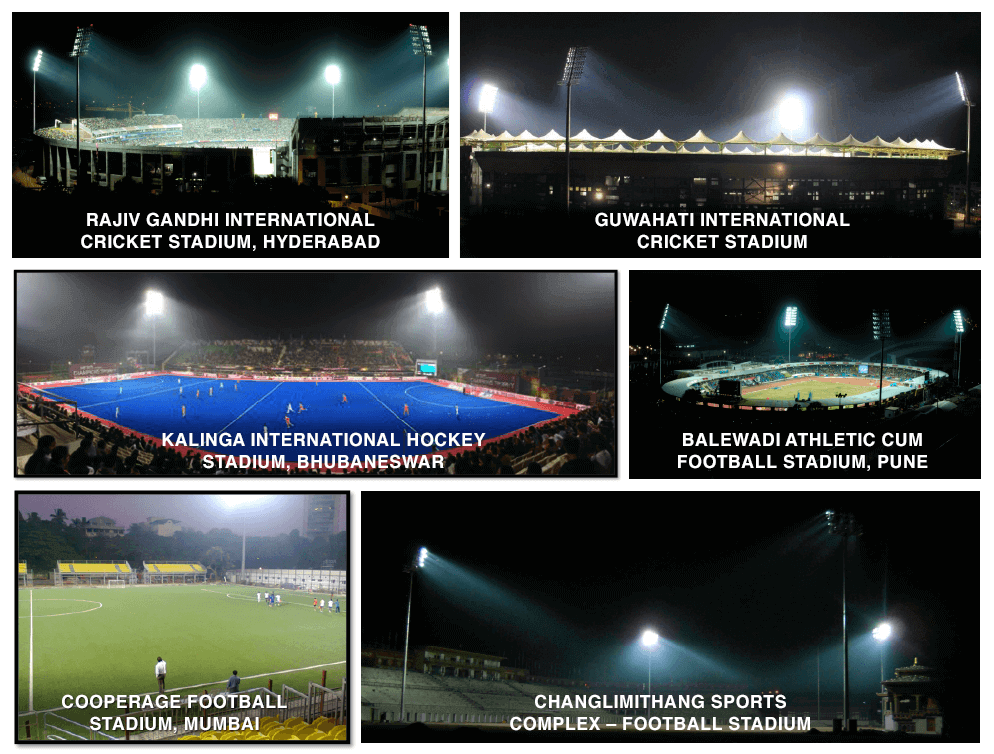Sports lighting is a type of lighting that is used to illuminate large areas for sports events. Artificial lighting is required when a game is being played after sunset, indoors or in an enclosed environment. The purpose of sports lighting is to provide ample lighting on the playing arena to ensure great visibility for both - the players as well as the audience. A good artificial lighting provides comfortable viewing environment to the players, umpires, referees, media crews, and spectators, as well as those who are enjoying the event telecast.
According to Stadium Lighting Market by Light Source, the stadium lighting market was approximately valued at USD 432.0 million in 2018 and is likely to reach USD 622.2 million by 2023, at a CAGR of 7.57%. Factors such as upcoming national and international sports events, enhanced stadium experiences, reduced costs and lifecycle operating costs of LEDs are boosting the demand for stadium lightings.
By illuminating over 135 sports arenas (outdoor and indoor), Bajaj’s Illumination segment occupies the leading position in the area of sports lighting.
Complying with the International Standards Guidelines, Bajaj successfully lit up the Wankhede Cricket Stadium ahead of the World Cup in 2011. Similarly, lighting solutions were provided to stadiums ahead of various national and international events such as National Games 2002, 2007 and 2012, Youth Commonwealth Games - Pune 2008, Lusofonia Games – Goa 2014, Asian Athletics & Sports Championship 2017 at Kalinga Athletic cum Football stadium, World Cup Hockey Tournament 2018 at Kalinga Hockey Stadium among others. Apart from these prestigious events, stadiums across the country such as Sawai Mansingh Cricket Stadium in Jaipur, ACA International Cricket Stadium in Guwahati, Cooperage Football Stadium, Rajiv Gandhi International Cricket Stadium in Hyderabad were illuminated by Bajaj.
When it comes to commissioning, the tallest lighting tower, the 72-metre-high masts each fitted with 112 numbers of 2KW metal halide floodlights and each mast weighing more than 40 tonnes at Mumbai’s Wankhede Stadium, are said to be the tallest and the heaviest polygonal high-mast structures used in the country for floodlighting of any stadium.
With in-house facilities for illumination designing, structural designing, engineering, procurement, and execution, backed by its own manufacturing plant for high masts, Bajaj offers turnkey solutions from “Concept to Commissioning” for any sports lighting requirement in India as well as abroad.

Balancing vertical and horizontal illumination level: The main purpose of the international level sports lighting system is to provide both vertical and horizontal illumination levels with a perfect balance suitable for HDTV transmission. It is important that the lights don’t hurt the eyes of the players, referees, and spectators and at the same time provide enough spill light for a great viewing experience.
Uniformity of illuminance: Uniform illuminance on the turf helps the players perform better during the event. It is also essential for high quality TV transmission while panning the camera from one side to the other.
Position of mast for outdoor stadium: The mast position should adhere to various international sports guidelines, keeping in mind the “Forbidden Zone / No Floodlight Zone”.
Selection of beam in design: It is important to select the correct beam for good quality lighting. A designer who has experience in this field, can help you select the right beam for your event.
Height of mast: Choosing a mast of the right height is very important for outdoor stadium lighting. It ensures comfortable viewing environment on FOP area by reducing glare, balances both horizontal and vertical illuminance level, and provides high quality uniformity level.
Switching: To optimize utilization and conserve energy, flexibility of switching is suggested for lower level matches like national, club, practice etc. Suitable luminosity is recommended for respective events.
Control on light pollution: As defined by the International Standards, spill light outside the stadium boundaries should be kept to bare minimum.
A superior quality illumination design for sports lighting requires precision in each of the above aspects and must be handled by experts in this field.
The advent of LED luminaires has broadened the horizon of the lighting industry, including sports lighting. Major advantages offered by the LED lighting over other conventional metal halide lights include:
With continuous upgradation in lumen efficacy and reduction in pricing, LEDs are fast emerging as a viable option over conventional luminaires.
Bajaj has already successfully illuminated many stadiums with LED luminaires and is fully geared up for executing international level sports lighting projects.